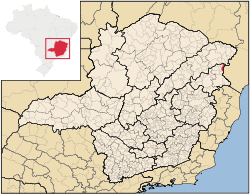
Bertópolis
Encyclopedia

Minas Gerais
Minas Gerais is one of the 26 states of Brazil, of which it is the second most populous, the third richest, and the fourth largest in area. Minas Gerais is the Brazilian state with the largest number of Presidents of Brazil, the current one, Dilma Rousseff, being one of them. The capital is the...
. As of 2007 the population was 4,588 in a total area of 426 km². The elevation is 278 meters. It became a municipality in 1962. The postal code (CEP) is 39875-000.
Bertópolis is part of the statistical microregion of Nanuque
Nanuque
Nanuque is a municipality in the northeast of the Brazilian state of Minas Gerais. As of 2007 the population was 40,307 in a total area of 1,515 km². It is part of the IBGE statistical meso-region of Vale do Mucuri and the micro-region of Nanuque...
. It lies on the boundary with the south of the state of Bahia
Bahia
Bahia is one of the 26 states of Brazil, and is located in the northeastern part of the country on the Atlantic coast. It is the fourth most populous Brazilian state after São Paulo, Minas Gerais and Rio de Janeiro, and the fifth-largest in size...
. It is connected by poor roads to the important highway BR-116, which lies to the west. The distance is 108 kilometers.
This is one of the poorest municipalities in the state and in the country. The main economic activities are cattle raising (31,000 head in 2006) and farming with modest production of coconut, sugarcane, and bananas. In 2006 there were 290 rural producers with a total agricultural area of 40,196 hectares. Cropland made up 3,800 hectares. There were only 5 tractors. In the urban area there were no financial institutions as of 2006. There were 70 automobiles, giving a ratio of about one automobile for every 60 inhabitants. Health care was provided by 4 public health clinics. There were no hospitals.
Municipal Human Development Index
Human Development Index
The Human Development Index is a composite statistic used to rank countries by level of "human development" and separate "very high human development", "high human development", "medium human development", and "low human development" countries...
- MHDI: .585 (2000)
- State ranking: 846 out of 853 municipalities
- National ranking: 4,908 out of 5,138 municipalities
- Life expectancy: 60
- Literacy rate: 64
- Combined primary, secondary and tertiary gross enrolment ratio: .652
- Per capita income (monthly): R$89.75 For the complete list see Frigoletto

